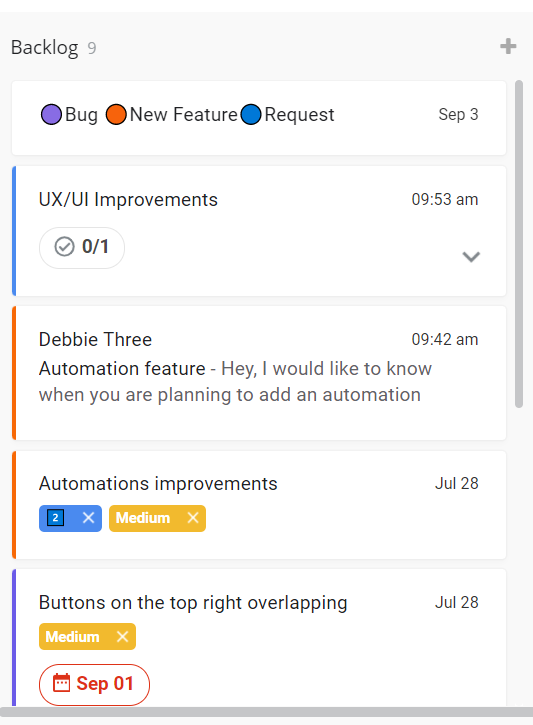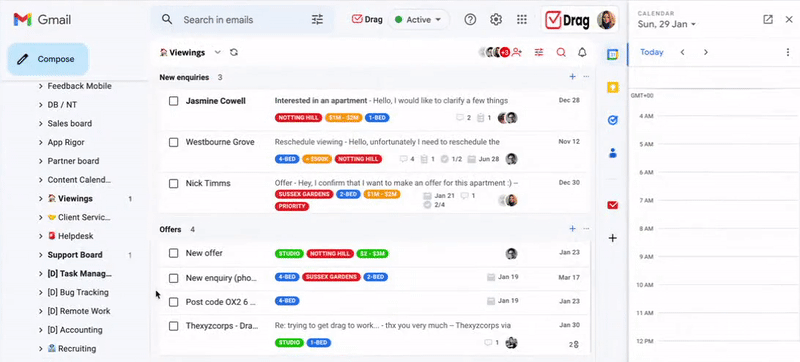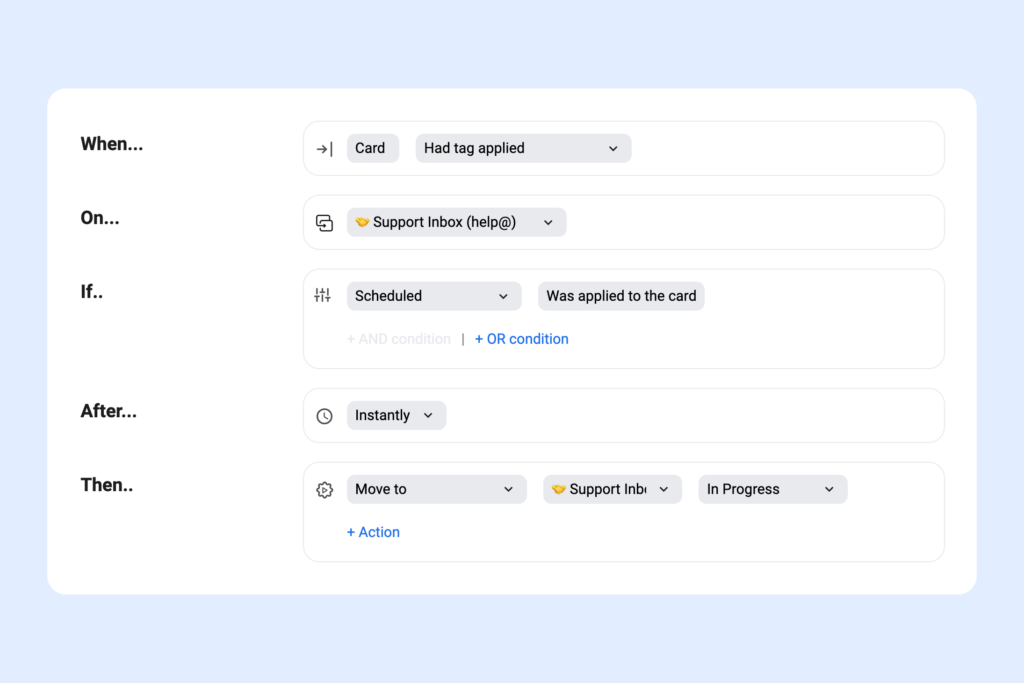
To improve and speed up your processes, you can build your sprint planning template in Gmail. And we are here to show you how to do it step by step.
There are multiple benefits to running your sprint workflow inside the most used free email service – Gmail stats show that 90% of US startups prefer it over other clients. To make it easier, you can develop practical sprint planning templates.
In this article, we’ll explore the possibilities and tools needed to make sprint planning work within Gmail. Keep reading for a comprehensive guide and best practices!
What is Sprint Planning?
Sprint planning, also called Agile sprint planning is one of the steps of the Scrum methodology. Product and engineering teams use it to prioritize their projects and get things done the right way. It also helps them to decide who will be able to join a specific project or task.
These teams need to have the ability to track their scrum capacity planning, to schedule the right projects at the proper time. And if they are able to run efficient sprint planning, they succeed in keeping their terms and delivering excellent results.
Sprint planning template: best practices
In order for a sprint to work, there are a few things to keep in mind:
1) Keep tasks simple
Your tasks shouldn’t be too complicated or overwhelming, otherwise they’ll stay on the same stage for a long time, defeating the purpose of a sprint. Instead, set up actionable subtasks that help your project move along the stages of development.
2) Set realistic goals
The same applies to the overarching sprint objective. The basis of the agile method is making incremental changes. So at each sprint, the team updates a product and service so that it’s closer to the final version.
To make it happen, your sprint planning template should include setting intentional, fast goals for this time frame. That way, the team doesn’t need to work on multiple things at once. Instead, they can give time and focus to the current priorities.
3) Be time-sensitive
A print planning template should acknowledge and respect the time allotted. Tasks and projects should work within a short period (sprints usually last from one to four weeks). After it ends, leaders can check the completion rates and team feedback to understand if the goal was balanced for the due date or if any changes need to be made.
Why implement Sprint planning in Gmail?
You can make your projects a lot more productive if you keep them in your inbox. We can bet that you receive many requests related to your projects via email. Most development and engineering teams do.
If this is your case, you can manage your sprints better by cutting down steps.
Here’s an example: say your team is working on a new software update. Every time a team member has to notify their collaborators of relevant changes, test results, and potential issues, they have to send yet another email with the whole context.
Then, these emails need to be summarized and added to a log on your task management software or wherever you organize your workflow. As tasks move through the needed steps, another email has to be sent to update everyone.
That leads to inbox clutter, misplaced files, and, of course, a lack of overall communication.
In contrast, here are some benefits of bringing sprint planning to Gmail:
Work in a visual way
The best task and project managers include different views to organize and predict your workflow. The Kanban view is popular among agile teams, as it highlights current tasks and helps people define priorities better. With the right tools, you can implement Kanban in Gmail, which transforms a traditional inbox into a productive, visual workspace.
Eliminate the back-and-forth between tools
Instead of listing all the features that the team will implement during the development process in different software, and making extensive sprint meetings, you can focus every communication in just one place: Gmail.
After all, switching between various tools can be time-consuming and lead to context-switching: a productivity loss from lack of momentum. On the flip side, if all the sprint chats happen where your tasks are, you don’t have to import and export task files, nor update each team member individually.
All the information you need
Everything you need to get things done in your sprint planning you can have in your inbox:
- Tasks and subtasks
- Email history
- Priority levels
- Links and files
- Deadlines
- Assignees
- Tags
- Notes
- Bug descriptions,
- Product specs
Sprint Planning Template: what you need
Subtasks
Before a task moves on to the next step of the sprint, it should be compliant with all guidelines. A good sprint planning template includes subtasks and checklists so that team members can easily check if everything is okay before moving a card to the next column.
File uploads
Your team also needs a well-defined space to keep their task-related files. If information is shared through multiple channels, it can get lost in cluttered inboxes, leading to additional time spent looking for it.
That means your sprint planning template should include a tab to upload files and add notes to current tasks. As they move through the sprint stages, the next team member can check for important resources far more easily.
Due dates

Sprints must have final due dates. And as soon as you define them, you should be able to add it to the task card and have it m,arked on the calendar.
Then, you can access the calendar and check for any planned events to plan your work schedule accordingly.
Color coding
Color coding is a great way to organize your sprint planning template. Usually, teams are working on multiple projects at a time, so they have to use an overarching board. However, with this comes a secondary challenge: not confusing task cards for each one.
For instance, if a team has two different products and both of them have cards named “Add integration”, there needs to be a quick way of knowing which one to work on. A good sprint planning template includes specific colors for each project, department, or whatever organizational scheme works for the team. That way, any user knows which type of task they’re working on at a glance.
Tags
The same thought process should happen for tags. Each one should help guide your team in understanding their workflow better. A good idea is to use tags to define priority levels. Then, when a user opens a card, they know how essential it is to the sprint.
Automations
Automations can be your allies during sprint planning and implementation. Some tools offer the option to add automation rules to the sprint board. That way, if you get new emails regarding a task they’re added to the right column.
Automated tagging can help during the sprint as well: for example, when a card regarding an update is moved to the Approval Needed column, the team leader and reviewer will receive a notification. Or, on the other hand, if a task includes a certain keyword, it’ll automatically receive a high-priority label.
Turn Gmail into your Team’s Workspace.
- 2.5x faster email responses.
- 20 hours less spent per month, per team member.
- 40% more deadlines achieved and happier teams.
Building a Sprint Planning Template in Gmail with a Shared Inbox

Creating a Sprint Planning template requires two main priorities: making sure the process is accessible to all team members and developing a replicable, flexible guideline.
Where do tasks come from?
A team inbox
Some sprint teams usually have alias email addresses, such as [email protected] or [email protected], for instance. And many of them still share logins and passwords to work inside their team accounts, so they extract the backlog from incoming emails.
Let’s face it: dev teams don’t have time to waste on complicated email steps, such as forwarding or copying emails between the team members to assign tasks. They need a clear workflow so that just with a look and a few clicks they can figure out the whole sprint plan.
So, with Drag, teams can set dynamic workspaces by implementing a Gmail shared inbox. That is, a collective space in which users can check and manage emails sent to the team inbox.
You can add all the team members to the shared board, where they will be able to read and reply to emails as part of a team without leaving their own accounts.
Emails that arrive in personal inboxes
Requests can also come from the team members’ personal inboxes, such as [email protected]. That’s why you can just drag emails from your inbox to the team’s inbox. Quick and easy.
Requests coming from other channels
There are times when feature requests can come from the company’s public roadmap, social media, or a third-party chat. Or even from a phone call or in person, depending on how the company works.
A shared inbox like Drag makes it possible to create new cards that you can fill with all the data available about these requests. Notice that you can also create cards inside shared boards, so you can centralize all your work in just one place.
That is, you should provide the correct workspace for the sprint planning to happen so that your team can benefit the most from it. Thankfully, this is a pretty straightforward process with our solution, DragApp.
First things first: Install Drag for free

This is the essential step before starting to build your template. You need to add Drag’s Chrome Extension to your browser. But don’t worry, it’s free and it just takes a few seconds. Then, open, or refresh your Gmail tab.
Next, a popup from Gmail’s authorizations will appear on the screen. You can read it, and then accept the permissions to allow Drag to work on your Gmail inbox.
Creating a custom board
- Open Gmail and click on the + icon next to Drag Boards

- You can pick from pre-existing workflows or set up your own:

- On Add incoming email, select Shared inbox:

- Write your team email, such as devs@companyname, and click Next.
- Now you’ll be redirected to your new workspace.
Adding your team to your board
Of course, the board is only useful when the team has access to it. To invite everyone, all you have to do is:
- Log into the board
- Click on the Share Board with team on the top right

- In the next screen, add the emails of the team members you want to invite:

Step 1: Use Kanban for a better view of work
Drag’s Kanban workspace view mode provides a holistic view of your sprint planning. You can visualize and interact with the board by setting columns with the necessary stages for your projects. These columns are adjustable, you can resize them if you need, and change their places if necessary.
Then you can easily drag and drop what we call cards (emails and tasks) between these columns. This process helps you change and track the sprints’ status in a much more clear and faster way.
Step 2: List your product backlog

The first column of your sprint planning template is the backlog. Here you can add your sprints in three different ways:
- Receive emails on a team shared inbox, such as product@ or dev@;
- Drag emails from a personal inbox to the team inbox;
- Create cards and fill them with backlog information;
Step 3: Define your tagging system
Drag has its own highly customizable and visual tag system. You can create custom shared tags for each kind of task and even add color coding to the mix. So whenever a team member logs into the board, they can easily get a glimpse of their next steps on the project.
Step 4: Assign tasks to team members
 Assignments are a key part of a successful sprint planning template. Managers should allocate tasks based on expertise, availability, and priorities so that no task is left undone before the next sprint.
Assignments are a key part of a successful sprint planning template. Managers should allocate tasks based on expertise, availability, and priorities so that no task is left undone before the next sprint.
Step 5: Set due dates
Your due dates are key. So when setting up sprint planning templates on a shared inbox, you should define them accordingly.
Usually, sprints last a month or less, so that teams can move faster through their projects. Then, as the sprint ends, the leader can collect feedback on task completion, overall balance between task lengths, and workload distribution. This data can be used later to define more efficient sprint planning templates.
With Drag, you can even organize your sprints easily through a Google Calendar integration. That way, users will have sprint periods added automatically to their calendars and receive all the relevant notifications.
Step 6: Chat with the teammates with context
 What if you could eliminate some time on the sprint planning meetings? Actually, with Drag, you can. In each card of your board, there is an internal chat, where you can exchange information about its content.
What if you could eliminate some time on the sprint planning meetings? Actually, with Drag, you can. In each card of your board, there is an internal chat, where you can exchange information about its content.
It makes teams concentrate the conversations about a specific matter right where it is. With no need to mention the whole context in a third-party tool, such as Slack or Google Chat.
If you type @ and the name of a team member, they will automatically receive an email, notifying them that they need to take action in that specific sprint. The messages arrive in real-time, and they stay there on the card, so you can read it at any time to have all the context you need.
They’ll also be notified on Drag’s activity log, so that the next time they open the shared inbox, all relevant changes are listed accordingly. This is particularly useful for asynchronous global teams since it eliminates the need for contextual email threads and long remote meetings.
Step 7: Review your sprint
The final step of a sprint is receiving feedback. After the predefined time elapses, managers should do a review to address productivity, potential bottlenecks, and points of improvement.

With Drag’s analytics reports, they can check different data, such as response time reports. That gives a reliable set of information about the overall productivity rates, which types of tasks are faster and slower to complete, and what has delayed the sprint.
Then, teams should have the space to offer their own feedback with internal perspectives on what worked and what didn’t during the time. With all of that in mind, the next sprint can be better designed and adapted to the team’s workflow.
Wrapping up
Now you are all set to start using Gmail as your new workflow for scrum sprint planning. With Gmail’s easy interface and shared inbox software’s resources, your team has everything they need to work on current projects right where tasks start.
As a bonus, with a tested and optimized sprint planning template, the overall productivity rises, as well as project conclusion and company growth.
Turn Gmail into your Team’s Workspace.
- 2.5x faster email responses.
- 20 hours less spent per month, per team member.
- 40% more deadlines achieved and happier teams.















